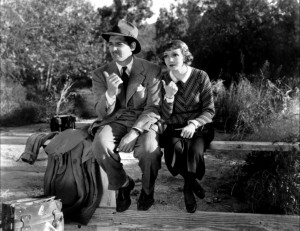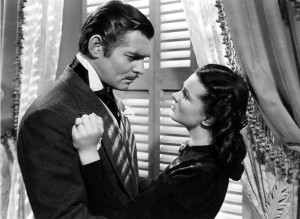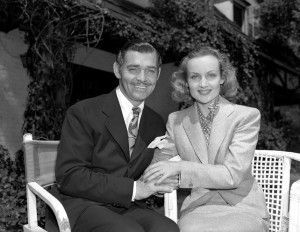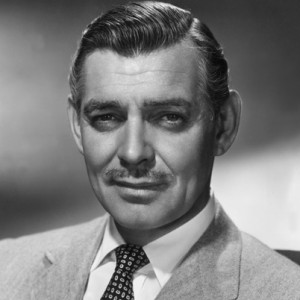 When I was a young girl I remember watching Clark Gable in the old classic movies and two of my favorites were “Gone with the Wind” in which Gable starred with Vivian Leigh in the epic Civil War drama and “It Happened One Night” in which he starred opposite Claudette Colbert in a story about a wise-cracking newspaper reporter and a feisty heiress on the run to avoid her wedding. I thought he was the most handsome man I had ever seen … except of course for my Dad! A funny story is that I think my Dad looked a lot like Clark Gable when he was younger with his perfectly trimmed skinny moustache and the fashionable way of dressing in great suits during the 1940s. (In his later years, my Dad started to look like Walt Disney to me … but that is another story for another time!!)
When I was a young girl I remember watching Clark Gable in the old classic movies and two of my favorites were “Gone with the Wind” in which Gable starred with Vivian Leigh in the epic Civil War drama and “It Happened One Night” in which he starred opposite Claudette Colbert in a story about a wise-cracking newspaper reporter and a feisty heiress on the run to avoid her wedding. I thought he was the most handsome man I had ever seen … except of course for my Dad! A funny story is that I think my Dad looked a lot like Clark Gable when he was younger with his perfectly trimmed skinny moustache and the fashionable way of dressing in great suits during the 1940s. (In his later years, my Dad started to look like Walt Disney to me … but that is another story for another time!!)
William Clark Gable was a born on February 1, 1901 in Cadiz, Ohio to an oil well driller father named William Gable and his wife Adeline Hershelman. Sadly, when Gable was only 10 months old his mother died and in 1903 Gable’s father married Jennie Dunlap. The young Gable was very tall for his age and because of his stepmother’s influence he always very clean and wore nice clothes. His stepmother gave Gable piano lessons but he also like to work on cars with his father. Gable’s father wanted him to hunt, fish and do hard physical work but Gable enjoyed reading and he liked to recite Shakespeare’s sonnets. By 1917, his father had financial problems and the family moved to a small farm in Ravenna near Akron, Ohio. Instead of working on the farm as his father expected him to do, Gable left to work in the Goodrich tire factory in Akron.
By the time Gable turned 21, his stepmother had died and his father mover to Tulsa. Gable was inspired to become an actor and found work in several different theater companies that eventually had him moving to Oregon. He supported his amateur acting career by working odd jobs as a logger and a salesman for a local department store. It was while working in the local theater company that Gable meet Laura Hope Crews who encouraged him to pursue acting as a full-time career (many years latter Crews would play the part of Aunt Pittypat in Gone with the Wind).
Around this time Gable met a woman that would soon become a great influence in his life, she was Josephine Dillon a Portland theater manager and she later became his acting coach and personal manager. She helped Gable to improve his stage presence by working on voice control, facial expressions and body posture. She also offered him financial aid to improve his appearance by getting his teeth repaired, his hair styled and he started wearing better clothes. With those personal improvements and better acting skills Dillon decided that Gable was ready to attempt a film career.
In 1924, Gable and Dillon, who were now married, went to Hollywood and for the next few years Gable was only able to find work as an extra in silent movies. Unfortunately Gable was not offered any substantial film roles and he decided to return to the stage. By 1927 Gable was working for a Houston theater company and with his good looks and improved acting skills he soon had moderate success as a local matinee idol. Gable and Dillon now decided to try their luck in New York.
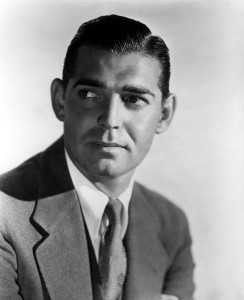 Gable received good reviews from his parts on Broadway but then the Great Depression hit and combined with a new form of entertainment, “the talking pictures”, many plays were cancelled making acting roles very harder to find. On a personal level, Gable had recently meet a Texas socialite named Maria “Ria” Langham and he quickly divorced Dillon. Gable now decided to give Hollywood another try and in 1930 MGM studios offered him a small contract and he began playing supporting roles in low-budget films and Gable starting receiving attention from the movie fans.
Gable received good reviews from his parts on Broadway but then the Great Depression hit and combined with a new form of entertainment, “the talking pictures”, many plays were cancelled making acting roles very harder to find. On a personal level, Gable had recently meet a Texas socialite named Maria “Ria” Langham and he quickly divorced Dillon. Gable now decided to give Hollywood another try and in 1930 MGM studios offered him a small contract and he began playing supporting roles in low-budget films and Gable starting receiving attention from the movie fans.
In the beginning most of the roles Gable played were villainous characters but with the increase in fan mail to the studios, MGM started developing Gable into a strong, manly and rugged character for larger parts. In some of his first leading man roles he played opposite many equally strong yet feminine women, such as Barbara Stanwyck, Greta Garbo, Marion Davies. He went on to work with Joan Crawford in eight films; she was his personal favorite actresses to work with. He also worked with Myrna Loy in seven films, Jean Harlow in six films, Lana Turner in four films and he worked with Norma Sherer and Ava Gardner in three films each. His final film was “The Misfits” in which he starred opposite Marilyn Monroe.
Gable received his first Oscar nomination for his lead role in the 1934 movie “It Happened One Night”. There is an interesting Hollywood story that goes as follows: MGM studio head, Louis B. Mayer, lent Gable to Columbia Pictures as punishment when Gable started refusing to take roles that he felt had bad movie scripts and deemed inferior to his newfound leading man status. Gable was cast opposite Claudette Colbert with Frank Capra as the film’s director. The movie went on to win the Academy Award for Best Picture and both Gable and Colbert won for Best Actor and Best Actress. Gable had his sweet revenge against Mayer and he returned to MGM an even bigger star!
Gable was now on a roll and he received another Academy Award nomination for Best Actor for his portrayal of Fletcher Christian in the 1935 movie “Mutiny on the Bounty”. He did not win but he was now receiving the recognition for his acting that he so rightly deserved.
By this time Gable was separated from his second wife and he had met the love of his life, actress Carole Lombard. They had appeared in the 1932 “No Man of Her Own”. At the time Gable was married to Langham and Lombard was married to actor William Powell. Their romance started in 1936 after getting reacquainted at a Hollywood party and they were soon madly in love. Gable felt that Lombard was a woman he could totally depend on for companionship and she learned to enjoy all the hobbies that he loved, such as camping, fishing and hunting.
Langham was giving Gable are difficult time in obtaining a divorce and it proved to be a very lengthy and expensive process. Then the opportunity of starring in “Gone with Wind” came about by popular demand for the fans for Gable to play the character of Rhett Butler. The movie was destined to be his most famous role and more importantly to Gable it was an opportunity for a larger salary and that allowed him to finalize a divorce settlement with Langham. Happily, during the filming of “Gone with the Wind”, Gable and Lombard were finally able to get married. Gable also received his third Academy Award Best Actor nomination for the role in the movie but he did not win much to the public’s disappointment.
The marriage of Gable and Lombard proved to be the happiest period in his personal life. They led a very simple life and enjoyed their time together away from the pressures of Hollywood. They lived on a farm in the San Fernando Valley just over the hill from the movie studios. Sadly, their happiness was cut short when in 1942 Lombard was killed in a plane crash during a tour to promote the selling of war bonds. Her mother and agent were also killed on the flight along with another 19 passengers.
Gable went into a deep depression and following Lombard’s death he joined the U.S. Army Air Forces. After his military training Second Lieutenant Gable was sent overseas to England. Gable flew in five combat missions during World War II but after a close call during one of the flights MGM studio executives urged the military to have him reassigned to non-combat duties. He returned stateside in 1943 to complete a film he had been previously working on. In 1944 Gable was promoted to major but no further military orders came and he was relieved from active duty at his request and he was officially discharged.
After the war, Gable returned to Hollwood and made 27 more films. Gable was to become involved in several affairs with young stars such as Virgina Grey, Paulette Goddard and Gene Tierney. He also had an affair with Grace Kelly while they were filming the movie “Mogambo”. He married again in 1949 to a British divorcee, Sylvia Ashley but that relationship quickly ended in divorce in 1952.
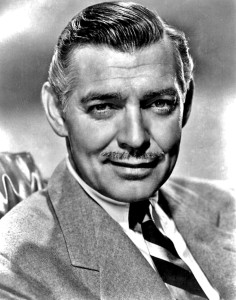 During the early 1950s things were changing in Hollywood and Gable was unhappy with the mediocre roles he was receiving from MGM and in 1953 he did not renew his contract with the studio and he began to work as an independent actor not afilliated with a particular studio. In 1955, Gable married his fifth wife, Kay Williams and former model and actress. Gable went on to appear in several unsuccessful movies and his health was being to fail. Gable’s last film was the 1961 movie “The Misfits” costarring Marilyn Monroe and Montgomery Cliff. Many movie critics consider it on of Gable’s finest performances.
During the early 1950s things were changing in Hollywood and Gable was unhappy with the mediocre roles he was receiving from MGM and in 1953 he did not renew his contract with the studio and he began to work as an independent actor not afilliated with a particular studio. In 1955, Gable married his fifth wife, Kay Williams and former model and actress. Gable went on to appear in several unsuccessful movies and his health was being to fail. Gable’s last film was the 1961 movie “The Misfits” costarring Marilyn Monroe and Montgomery Cliff. Many movie critics consider it on of Gable’s finest performances.
Gable died on November 16, 1960 from a coronary thrombosis ten days after suffering a severe heart attack. At the time, his wife Kay was pregnant and sadly she gave birth to their son, named John Clark Gable, on March 20, 1961 at the same hospital where four months earlier she had lost her husband. Clark Gable is interred in the mausoleum at Forest Lawn Cemetery in Glendale, California beside his beloved third wife, Carole Lombard.

